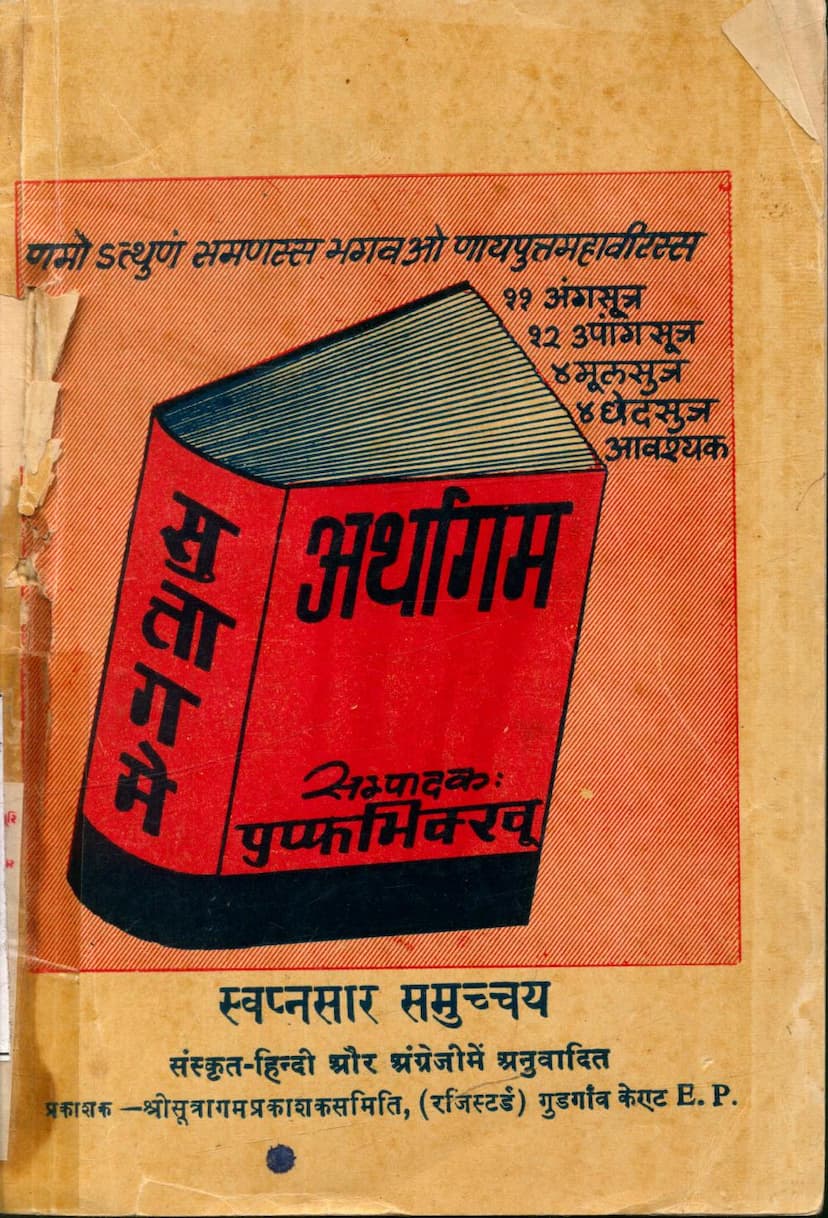Swapna Sara Samucchay
Added to library: September 2, 2025

Summary
Here's a comprehensive summary of the Jain text "Swapna Sara Samucchay" by Durgaprasad Jain, based on the provided pages:
Book Title: Swapna Sara Samucchay (स्वप्नसार समुच्चय) Author: Durgaprasad Jain Publisher: Sutragam Prakashak Samiti, Gurugram Cantt.
Overall Purpose and Context:
The book "Swapna Sara Samucchay" is a compilation of insights into the nature and interpretation of dreams within the Jain tradition. It aims to provide the general public with a guide to understanding dreams, their causes, and their potential implications. The publication is presented as a service to the Jain community and the broader readership interested in dream interpretation.
Key Themes and Contents:
-
Nature of Dreams:
- Dreams are presented as a natural part of human experience, occurring in the state between waking and deep sleep.
- The text acknowledges that animals also dream, but unlike humans, they cannot articulate their dreams.
- The mind is identified as the primary cause of dreams. When the senses are dormant, the mind wanders freely, creating dream experiences.
- Specific events that create significant mental or emotional upheaval can manifest as dreams. The interpretation of their outcome is often linked to destiny (prarabdha) and individual interpretations.
-
Causes of Dreams:
- The Mind: The mind, being active even when the body rests, is the core driver of dreams.
- Mental State: Dreams are influenced by a person's mental state, including desires, anxieties, fears, and past experiences. Unfulfilled desires and suppressed emotions can manifest in dreams.
- Physical State: The physical health of an individual also plays a role. Illnesses can manifest as specific types of dreams.
- External Factors: Environmental influences like noise or pleasant sounds can also contribute to dream content.
- Doshic Imbalances: The text mentions that dreams can be caused by imbalances in the body's humors (Vata, Pitta, Kapha), categorizing these as "false" dreams.
- Divine Influence/Destiny (Daiva): Dreams caused by divine intervention or destiny are considered "true" and carry significant meaning.
- Unconscious Mind: A significant portion of the text delves into the concept of the unconscious mind, explaining how childhood experiences, suppressed desires, and unresolved conflicts reside there and influence dream content. It emphasizes the importance of understanding the unconscious to understand dreams and achieve self-improvement.
-
Types of Dreams:
- True vs. False Dreams: Dreams are broadly classified into true (predictive or meaningful) and false (meaningless or caused by physical imbalances).
- Dreams based on Time of Occurrence: The interpretation of a dream's effect is linked to the time of night it occurs (first quarter, second quarter, etc., with dreams closer to dawn having more immediate effects).
- Categorization of Dreams (Based on Jain Agamas): The text draws from Jain scriptures, specifically mentioning the Bhagavati Sutra, to outline five types of dreams:
- Yathathathya (As is): True or factual dreams, further divided into:
- Drishtarth-visamvadi: Events matching the dream occur.
- Phal-visamvadi: The outcome of the dream is realized later.
- Pratan: Elaborate or detailed dreams.
- Chinta (Thought-dreams): Dreams reflecting conscious thinking.
- Tadviparit: Dreams where the opposite of what is dreamt occurs.
- Avyakta: Unclear or indistinct dreams.
- Yathathathya (As is): True or factual dreams, further divided into:
- Categorization of Dreams (General): The text also broadly categorizes dreams based on their causes or the entities/objects seen in them, listing numerous examples.
-
Interpretation of Dreams and Their Effects:
- The book provides an extensive list of dream symbols (e.g., seeing a lotus, an elephant, a crow, a snake, deities like Lakshmi or Hanuman) and their associated interpretations, which range from positive outcomes (wealth, success, health, progeny) to negative ones (loss, grief, illness, death).
- The text emphasizes that the interpretation often depends on the context within the dream and the dreamer's own life circumstances.
- The concept of "Prachina-Vipaki" (dreams that bear fruit after a long time) and "Par-Vipaki" (dreams whose results affect others) is discussed in the context of certain prophetic dreams.
-
Jain Significance of Dreams:
- Tirthankara's Mother's Dreams: A significant portion is dedicated to the dreams of mothers of Tirthankaras and Chakravartis. These are considered highly auspicious and indicative of the great soul about to be born. The text lists specific dreams seen by the mother of Lord Rishabhadeva (Marudevi) and their interpretations, highlighting the prophetic nature of these divine dreams.
- Dreams of Mahavira: The book also recounts the ten Mahapranidhana (great propitiatory) dreams experienced by Lord Mahavira himself in his pre-enlightened state, and their symbolic interpretations related to his spiritual journey and teachings.
-
The Role of the Publisher (Shri Sutragam Prakashak Samiti):
- The preface highlights the Samiti's commitment to publishing sacred Jain scriptures (Agamas).
- They express gratitude to scholars worldwide for appreciating their work.
- The publication of "Swapna Sara Samucchay" is a continuation of their mission to make valuable Jain texts accessible.
- The initial plan to include illustrations was abandoned due to cost, and the book is presented with Sanskrit, Hindi, and English translations.
-
Psychological and Philosophical Underpinnings:
- The text touches upon psychological concepts like the unconscious mind, memory suppression ("regulatory police" of the mind), and the influence of emotions on dreams.
- It explores the philosophical idea that dreams are a manifestation of the mind's activity and can offer insights into one's inner state.
- The author and contributors emphasize that understanding dreams is a path to self-knowledge and spiritual progress.
In essence, "Swapna Sara Samucchay" is a detailed Jain guide that bridges the realms of ancient tradition, psychology, and practical interpretation of dreams. It aims to empower readers with knowledge about their dream experiences, grounding this understanding within the framework of Jain philosophy and scriptures.